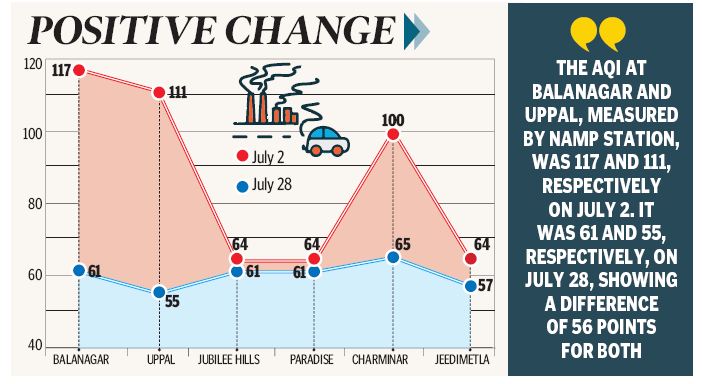Hyderabad air quality improves in July
As per PCB recordings, city has seen significant improvement in AQI values during the whole month
Published Date - 4 August 2021, 12:24 AM
Hyderabad: July has registered a marked improvement in the air quality in several places of the city including the industrial cluster of Balanagar and Uppal.
Even the air quality, as reflected in the regular data generated from across the city by the Telangana State Pollution Control Board (TSPCB), has improved at the busy commercial and tourist hub of Charminar.
However, the same could not be said about the ever-busy traffic main corridors of Jubilee Hills and Paradise. In these two locations of the city, which for most part of the day and late till night witness heavy movement of vehicles and are dotted with busy commercial zones, the improvement in air quality has been very little in July when compared to most other parts of the city.
According to the PCB recordings, there has been a significant improvement in the AQI values from the beginning of July itself and went on till the month-end.
Industrial areas like Balanagar and Uppal which usually show high levels of pollution, however actually showed a good improvement in the air quality during the month. The AQI at Balanagar and Uppal, as measured by the National Air Quality Monitoring Programme (NAMP) station, was 117 and 111 respectively on July 2. On July 28, the same NAMP stations registered AQI of 61 and 55 respectively, showing a difference of 56 points both.
In this context, it is imperative to understand that low AQI means a reduction in pollution. This means that the AQI at Balanagar went from being in a moderate range (101-200) to a satisfactory range (51-100) over the last one month. All other places are also in the satisfactory range.
The NAMP stations at Charminar, Jubilee Hills, Paradise and Jeedimetla also showed an improvement in AQI. Though those places showed a slight difference, Charminar registered a difference of 35 points, as the AQI was 100 on July 2 and it came to 65 on July 28.
Levels of microscopic particulate matter, oxides of nitrogen and sulphur, ammonia are considered to measure AQI. While the levels of particulate matter showed a consistent reduction over the month of July, other pollutants marginally increased at some places and decreased at some.
The reduction in particulate matter levels can be attributed to the recent rains, as wet conditions decrease suspended particles in the air.
